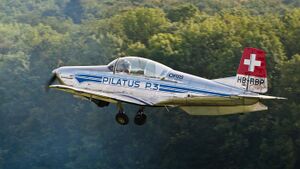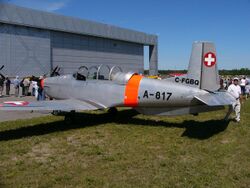Engineering:Pilatus P-3
| P-3 | |
|---|---|

| |
| Role | Trainer aircraft |
| Manufacturer | Pilatus Aircraft |
| First flight | 3 September 1953 |
| Introduction | 1956 |
| Status | in use in private hands |
| Primary users | Swiss Air Force Brazilian Navy |
| Number built | 79 |
| Developed into | Pilatus PC-7 |
The Pilatus P-3 was a military training aircraft built by Pilatus Aircraft of Switzerland .
Design and development
The Pilatus P-3 was designed for primary and advanced training (including night flying, aerobatics and instrument flying). The military versions were designated P-3-03 to P-3-05. It was of all-metal construction with a retractable tricycle undercarriage and tandem seating. There was provision for underwing racks for light practice bombs or rockets and a machine gun in a pod below the port wing. Although such kits were purchased, they were never used.[1]
Operational history
The first prototype P-3.01 was built in 1953 and flew on 3 September the same year[2] with a two-blade propeller. The power of the engine of the aircraft proved to be insufficient. A second prototype to become the military prototype flew in August, 1954, now equipped with a different engine and a three blade propeller. During the evaluation of the military prototype, now designated P-3.02 (HB-HOO, becoming A-801 in January 1956), the aircraft had to perform against a T-34 Mentor that had been brought to Switzerland.[3] The test pilot at the demonstration flight went to the limits and flew a standing "8", knowing, the Mentor would not be able to fly this manoeuvre.[4] After the acceptance by the Swiss Air Force , the service received a pre-series of 12 aircraft type P-3.03 (A-802-A-813). Six additional examples were built and flew with civilian markings, those P-3.04 were later acquired by the Brazilian Navy.[5] The Swiss Air Force then purchased 60 airframes of the type P-3.05 (A-814-A-873)[6] and used their P-3s as a training aircraft until 1983, although it continued to be used as a liaison aircraft for another decade. In 1993–1995, 65 ex-Swiss Air Force aircraft were sold on the private market.[7]
After two crashes resulting from an aircraft going into a flat spin, the aircraft A-858 received a ventral fin. After successful testing, all swiss P-3 received the fin.[4]
The prototype P-3.01 HB-HON was used by Pilatus' sister company Contraves as a target tug before returning to Pilatus to become the prototype of the PC-7 in 1966.[8]
Operators
 Brazil
Brazil
- Brazilian Navy
 Switzerland
Switzerland
- Swiss Air Force
- P3 Flyers
The P-3 Flyers is an independent air display team based in Switzerland.[9][10] Formed in 1996. it currently operates five ex-Swiss Air Force P3 aircraft.[11][12]
Specifications (Pilatus P-3-03)
Data from Jane's All The World's Aircraft 1958–59 [13]
General characteristics
- Crew: one
- Capacity: one passenger
- Length: 8.75 m (28 ft 8 in)
- Wingspan: 10.40 m (34 ft 1 in)
- Height: 3.05 m (10 ft 0 in)
- Wing area: 16.55 m2 (178.1 sq ft)
- Aspect ratio: 6.55:1
- Airfoil: NACA 64A series
- Empty weight: 1,090 kg (2,403 lb)
- Gross weight: 1,415 kg (3,120 lb)
- Max takeoff weight: 1,500 kg (3,307 lb)
- Fuel capacity: 160 L (42 US gal; 35 imp gal)
- Powerplant: 1 × Lycoming GO-435-C2-A2 6-cylinder air-cooled four stroke horizontally opposed piston engine, 190 kW (260 hp)
- Propellers: 3-bladed Hartzell constant-speed propeller
Performance
- Maximum speed: 310 km/h (190 mph, 170 kn) sea level to 2,000 m (6,600 ft) at 1,500 kg (3,307 lb) AUW
- Cruise speed: 252 km/h (157 mph, 136 kn) economical cruise
- 275 km/h (171 mph; 148 kn) maximum cruise
- Stall speed: 100 km/h (62 mph, 54 kn)
- Never exceed speed: 500 km/h (310 mph, 270 kn)
- Range: 750 km (470 mi, 400 nmi) maximum in still air
- Service ceiling: 5,500 m (18,000 ft)
- Absolute ceiling: 5,100 m (16,700 ft)
- Rate of climb: 7 m/s (1,400 ft/min)
- Wing loading: 90.63 kg/m2 (18.56 lb/sq ft)
- Power/mass: 0.12 kW/kg (0.073 hp/lb)
- Take-off distance to 15 m (49 ft): 342 m (1,120 ft) on hard runway at sea level
- Landing distance from 15 m (49 ft): 390 m (1,280 ft) on hard runway at sea level
See also
Related development
Aircraft of comparable role, configuration and era
References
- ↑ Roland Eichenberger: Pilatus Flugzeuge: 1939–1989, Pilatus Flugzeugwerke, Stans 1989, page 12
- ↑ Bridgman, Leonard, ed (1956). Jane's All the World's Aircraft 1956-57. London: Sampson Low, Marston & Company, Ltd. p. 223.
- ↑ Ausgemusterte Mittel der Schweizer Luftwaffe
- ↑ Jump up to: 4.0 4.1 Pilatus P-3 History, April 27th, 2021
- ↑ Die Geschichte des P-3, Pilatus, Werner Meier
- ↑ Roland Eichenberger: Pilatus Flugzeuge: 1939–1989, Pilatus Flugzeugwerke, Stans 1989.
- ↑ " History: Pilatus P-3." Pilatus P-3 Retrieved: 9 November 2012.
- ↑ Roland Eichenberger: Pilatus Flugzeuge: 1939–1989, Pilatus Flugzeugwerke, Stans 1989
- ↑ The P-3 is an all-metal aircraft with tricycle landing gear , pilatus-enthusiasts.com.au (retrieved 25 January 2015)
- ↑ Dai Pilatus P3 Trainers ai Pilatus P3 Flyers (pdf) (From Pilatus P3 trainers to Pilatus P3 flyers), retro.seals.ch (retrieved 25 January 2015)
- ↑ Vola con il Pilatus dei P3 Flyers - Acrobazia aerea (Fly with the Pilatus P3 Flyers - Aerobatics), volarein.com (retrieved 25 January 2015)
- ↑ P3 Flyers, Aeroclub Parma (retrieved 25 January 2015)
- ↑ Bridgman, Leonard, ed (1958). Jane's All the World's Aircraft 1958-59. London: Jane's All the World's Aircraft Publishing Co. Ltd.. p. 247.
Bibliography
- Genève, Alain (January 1990). "50 ans d'aviation au pied du Mont Pilatus (2): Le Pilatus P-3" (in fr). Le Fana de l'Aviation (242): 18–21. ISSN 0757-4169.
External links
- "Pilatus P-3". http://www.pilatusp-3.com/index.php?option=com_content&task=view&id=34&aItemid=38. Retrieved 3 April 2020.
 |





